Training your back and biceps together in the same workout is something very common in bodybuilding training routines.
It doesn’t matter whether you are a beginner or an advanced gym lifter. You need a good workout routine to optimize your muscle gains.
I’m super excited to share with you my all-time favorite (based on science and experience) back and biceps exercises with workout routines. Trust me, once you try this power pair, you’ll wonder why you didn’t start sooner.
We’ll break down exercises for every muscle group, with options for gym and home warriors (because, let’s face it, sometimes the gym isn’t an option).
Let’s do this!
Want to take your gains to the next level? Discover your daily calorie needs with our free TDEE calculator

- Why You Should Train Back and Biceps Together
- 12 Best Back and Bicep Exercises for Mass and Strength
- 1. Pull-Up
- 2. Lats Pulldown
- 3. Seated Cable Row
- 4. Bent Over Barbell Row
- 5. Upright Row
- 6. One Arm Dumbbell Row
- 7. Barbell Curl
- 8. Chin Up
- 9. Cable Curl
- 10. Reverse Curl
- 11. Incline Dumbbell Curl
- 12. Hammer Curl
- Back and Bicep Training Techniques and Routines
- 1. Select Training Goal
- 2. Choose Weekly Sets Based On Experience
- 3. Select Back And Biceps Workout Split
- 4. Back And Bicep Workout Routine for Beginner
- 5. Workout Routine for Intermediate
- 6. Back and Biceps Advance Workout Plan
- 7. Back and Bicep Superset Workout Plan
- FAQs.
- Can you train back and bicep together for mass?
- How Many Sets and Reps Should I Do?
- How long should a back and bicep workout be?
- How frequently should I train my back and bicep?
- Takeaways
Why You Should Train Back and Biceps Together
During a compound back workout, the primary muscles worked are definitely the back muscles, but many other muscles (biceps, rear delts, and traps) also work as synergistic and stabilizer muscles.
Training back and biceps together in the same workout isn’t some new fad. Bodybuilders have been doing it for ages, and for good reason. The reason for training those muscle groups together is very logical.
Take the pull-up, for example. Your back muscles (lats) are the show’s star, but they don’t work alone. Your biceps, rear deltoids (shoulder muscles), and traps (upper back) are all synergists and stabilizers, helping you pull yourself up with perfect form.
This meta-analysis also supported the idea that compound exercises were more effective at building muscle mass than isolation exercises.
During your workout routine, you must first train your back rather than your biceps. This is because your back muscle will need your full energy and is most likely the heaviest to train and gain in terms of muscle.
12 Best Back and Bicep Exercises for Mass and Strength
Here are 12 exercises to help you build back and biceps in the gym. You can use these as part of a regular workout or as a standalone circuit.
1. Pull-Up
The pull-up is an upper-body strength exercise that targets your back and bicep. Pull-ups are a challenge for beginners and experienced athletes.
The wide-grip pull-up is harder to perform than a standard pull-up because it places your hands further from the center of your body, making the exercise more difficult.
It increases the strength, thickness, and width of your back, specifically your lats. The lats widen the back and form the “V” in the upper back.
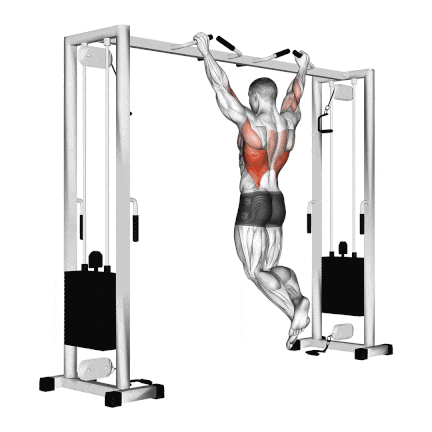
How To Do It
- Using an overhand grip, grab a pull-up bar with your hands wider than shoulder-width apart.
- Hang from the bar with your arms fully extended and your chest high, while exaggerating the arch in your lower back.
- Pull yourself up by contracting your lats and squeezing your shoulder blades together.
- Hold the contraction at the top for a second before slowly lowering yourself back to the starting position.
2. Lats Pulldown
The lat pulldown is an exercise used to build the back muscles. It is a great exercise for the back that fitness trainers widely use to build bigger lats.
Targeting your back muscles is important to help with proper posture and ease pulling movements. This exercise can be performed using wide and narrow grips, pulling to the front and the back.
The wider grip is the best variation to target the outer lats. You should add this back and bicep workout to your exercise arsenal.
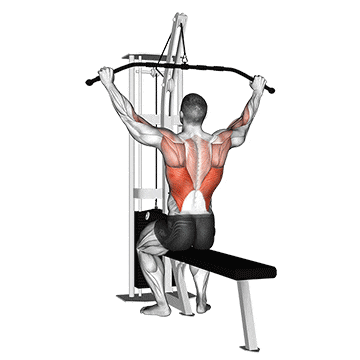
How To Do It
- Sit on the machine seat with an overhand grip, hands slightly wider than shoulder-width apart.
- Lock your knees under the support pads.
- Keep your upper back straight, pull the bar down, and bring it up to the chest.
- As you pull down, squeeze your shoulder blades together and feel your back muscles contracting.
- Use your upper lats to perform this movement, and consider your arms to be nothing more than a lever between the bar and your lats.
- Now let go of the bar slowly and stretch your lats as much as possible.
3. Seated Cable Row
Seated Cable Row is a compound strength training exercise that primarily targets the upper back muscles, including the latissimus dorsi, rhomboids, and trapezius. It also trains the bicep, brachialis, and forearm muscles.
You can use different attachments for cable rows for variations.
- V-bar attachment
- Wide D Handle Row Bar
- Straight bar
- Rope
- Zigzag Handle
- D Handle
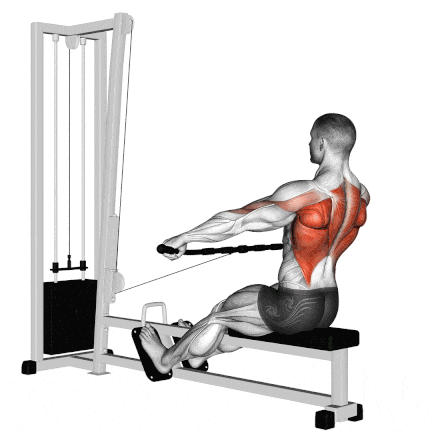
How To Do It
- Sit on a seated cable pulley rowing machine with legs bent and feet supported against the crossbar.
- Grab the handles with your arms extended and your back stretched.
- Keep your back straight and your elbows close to your sides, and then pull the handle towards your chest,
- Squeeze your lats at the movement’s top, then slowly lower the weight back to the starting position.
- Slowly return the handle to the starting position.
4. Bent Over Barbell Row
A bent-over barbell row is a compound exercise that works the muscles of your back, particularly the latissimus dorsi (lats), trapezius, rhomboids, erector spinae and also works the bicep.
Spacing your hands shoulder-width apart or closer targets the central inner section of the lats, whereas a wider grip targets the outer back muscles.
- A narrow grip keeps the elbows close to the body, making it harder to extend the shoulders and pull them away from the body. This forces the lats muscles to work harder, strengthening them.
- The wide grip encouraged by the flared elbows helps reduce lats involvement, allowing you to target the rhomboids, traps and rear delt.
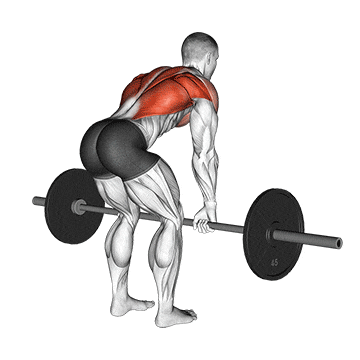
How To Do It
- Stand with a narrow stance and grab a bar with an overhand grip.
- Bend your torso forward at an angle of 45 degrees to the floor with the knees slightly, and let the bar hang in front of you.
- Now use the back and raise the bar until it touches the abdominal region and not the chest region, as it reduces back muscle contraction.
- Slowly lower the bar under control to the starting position.
5. Upright Row
The upright row is a weightlifting exercise that targets the muscles of the shoulder and upper back, including the deltoids, trapezius, rhomboids, and even the biceps. It is a great addition to any full-body workout.
There are three main variations of grip width: close grip, normal grip, and wide grip.
- The normal grip upright row provides overall shoulder development and is suitable for those seeking balanced muscle activation.
- The narrow grip upright rows places emphasis more on the upper trap and a little lesser on the lateral delt and rear delt.
- The wide-grip upright row places heavy emphasis more in the lateral and rear deltoid and little lessor on the upper and middle trap
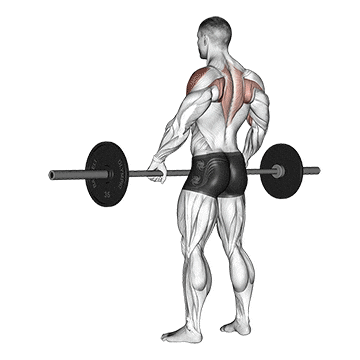
How To Do It
- Hold a bar with a narrow overhand grip and let it hang in front of you.
- Lift the bar and get it as close as possible to the chin, using your arms and elevating your shoulders to squeeze your trapezius muscles.
- Now, lower the bar under controlled motion until it returns to its starting position.
- Repeat for desired reps.
6. One Arm Dumbbell Row
One-arm dumbbell Row is a simple yet effective exercise that will help you build a bigger and stronger back and improve your posture.
One of the benefits of doing a dumbbell row is that it allows you to train each side independently, thereby providing better muscle isolation. Additionally, they provide full-range motion to build the lat muscles.
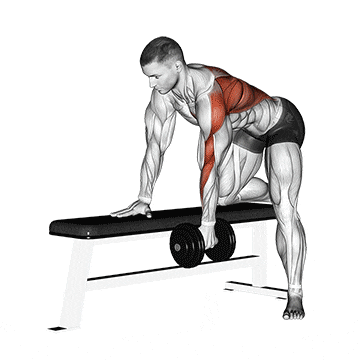
How To Do It
- Grasp a dumbbell with the palm facing in. Rest the opposite hand and knee on a bench.
- Pull the dumbbell vertically upward alongside your torso, raising the elbow as high as possible.
- Lower the dumbbell as slowly as possible, feeling a good stretch in your lats.
- Repeat on the other side.
7. Barbell Curl
The barbell curl is a highly recognizable biceps exercise that builds biceps muscle mass. It’s a great exercise for seeing results in strength and definition.
It is a pull-type, isolation exercise that works primarily on your biceps and also trains the muscles in your forearms.
A wide grip focuses effort on the inner biceps (short head), whereas a narrow grip arks the outer biceps (long head).
Note: In the study conducted, they found that the EZ barbell curl showed the highest overall electromyography (EMG) activity in the biceps brachii (BB) and brachioradialis (BR) muscles compared to the dumbbell curl (DC) and barbell curl (BC) variants.
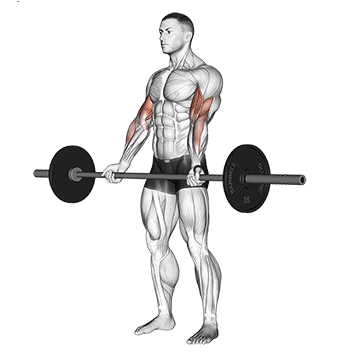
How To Do It
- Hold a barbell at arm’s length, using a shoulder-width underhand grip.
- Curl the bar up to shoulder level by bending your elbows.
- Lower the bar back down to the arms’ extended position.
- Repeat for desired reps.
8. Chin Up
Chin-ups and pull-ups are both exercises that target the upper body, specifically the back muscles such as latissimus dorsi, trapezius, rhomboids and shoulders, and arms. They are both performed using a pull-up bar, and the main difference between the two exercises is the grip used.
During chin-up, the palms face towards the body while gripping the bar (underhand or supinated grip). This grip targets the biceps more than the back and shoulders.
Since the lifter is pulling their bodyweight, the biceps are usually exposed to loads heavier than what one can lift with a barbell.
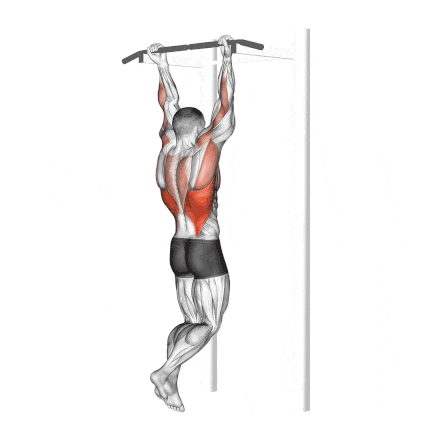
How To Do It
- Grab a pull-up bar with an underhand grip (palm facing toward the body), hands shoulder-width apart or slightly narrower.
- Straighten your arms, keep your knees bent and cross your lower legs. It can also be done with a straight leg.
- Retract your shoulder blades and pull your body up until your chin aligns with the bar.
- Pause at the top for one to two seconds with the biceps under maximum tension. Slowly lower to the start position.
9. Cable Curl
The bicep cable curl is one of the best isolation exercises for the upper arm biceps muscle. It’s a pulling action performed with a cable machine and is suitable for beginners.
Cable curls are done with a cable machine, giving you constant resistance while exercising. This helps to target the biceps more effectively than other exercises, such as dumbbell curls.
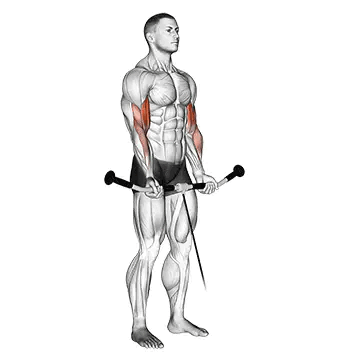
How To Do It
- Set up the cable curl by attaching a straight bar to the low pulley cable.
- Grasp the bar with an underhand grip (palms facing up), and your hands about shoulder-width apart.
- Curl the bar up toward your shoulders by bending at the elbows.
- Lower the weight down to the arm’s extended position.
10. Reverse Curl
The reverse curl is a variation of the bicep curl exercise that targets the muscles from a different angle. Unlike the traditional bicep curl, the barbell reverse curl is performed with an overhand grip (palms facing down) on the barbell.
A pronounced grip will engage the brachioradialis and other forearm muscles to a greater extent. This also helps to improve grip strength and forearm and bicep development.
Other ways to do the Reverse Curl:
- Cable Reverse Curl
- Dumbbell Reverse Curl
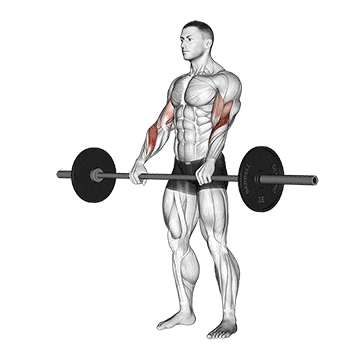
How To Do It
- Stand up straight with your feet shoulder-width apart.
- Grasp the barbell with an overhand grip, slightly wider than shoulder-width apart.
- Exhale and slowly curl the barbell upwards toward your shoulders.
- At the top of the curl, feel the contraction in your biceps and forearms.
- Inhale and slowly lower the barbell back down to the starting position.
11. Incline Dumbbell Curl
The Inclined dumbbell curl is an excellent full-range exercise for building bigger muscles and adding variety to your bicep exercise plan.
It is a variation of the dumbbell curl and an exercise used to build bigger biceps. The incline dumbbell curl elongates the negative portion of the dumbbell curl by creating a deeper stretch on the biceps muscle tissue.
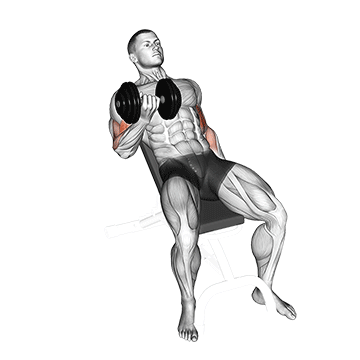
How To Do It
- Position an incline bench at roughly 45-60 degrees. Sit on it with a pair of heavy dumbbells.
- Curl the dumbbells up to shoulder levels and then curl back to the start position.
- At the top of the movement, contract harder and let the palms face you, and at the end of the movement, let the palms face each other.
- Repeat for the desired number of repetitions.
12. Hammer Curl
The Hammer Curl is a classic weightlifting exercise that targets the biceps and forearms. It strengthens the three largest muscles along the front of your upper arms.
It is different from the regular bicep curl as it involves an overhand grip with a pronated wrist, instead of an underhand grip.
The hammer curl is one of the most popular bicep exercises among bodybuilders and regular weightlifters, and it is used to build muscular hypertrophy and strength.
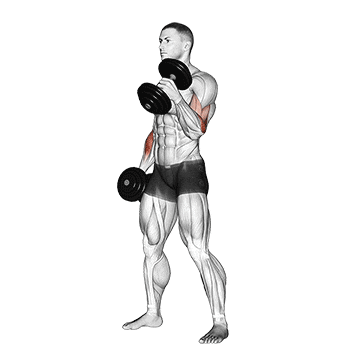
How To Do It
- Stand with your feet shoulder-width apart and a slight bend in your knees.
- Hold a pair of dumbbells in your hands with your palms facing towards your body.
- Keeping your elbows close to your body, slowly curl the dumbbell up to your shoulders.
- Pause at the top of the lift for a second, squeeze your biceps, and then lower the weights under control.
Back and Bicep Training Techniques and Routines
1. Select Training Goal
Some people prefer to perform back and bicep exercises for strength, while others are more interested in workouts for building muscle.
Again, the different training goals will mostly affect the number of reps, sets, and weights performed for the back bicep workouts.
- Strength training involves lifting heavy weights. Powerlifters and weightlifters routinely train with weights in the 1–5 repetition range (>85% of 1RM). Although higher rep ranges (less than 6 reps) have also been proven effective for strength gains.
- Muscle growth training has more to do with challenging and tiring out your muscles. As long as you push your muscles close to failure. You will obtain best muscle growth in the range of 5–12 reps per set (~60–85% of 1RM).
- For endurance, do the 15 to 20+ reps.
2. Choose Weekly Sets Based On Experience
In this context, training volume refers to how much work we do for a particular body part. The simplest way to lay out volume is in terms of the sets being done.
- Beginners: ~10 sets per week.
- Intermediate: ~15 sets per week.
- Advanced: ~20 sets per week.
Note: Do you remember that the biceps are involved in most back exercises? If you were to do 10-20 sets for the back each week, you would not also need 10-20 sets for the biceps because the biceps would already receive a lot of secondary volume while training the back.
3. Select Back And Biceps Workout Split
There are numerous different workout splits you can use that involve having a “back and biceps day.”” However, they would all fall into one of two categories.
- A body part split: Workout routines that train related muscle groups on separate days.
- A Push Pull Legs split: Workout routines that train related muscle groups on the same day.
You can use this with any other program you have.
To give you an idea of how this workout can fit into various programs, I wanted to give you a rough estimate of how often you could do it without interfering with other workouts. You could probably do it twice a week without interfering with other workouts.
Body Part Routine Split
If you have a 4 or 5 day body part split:
- Day 1: Back and Bicep Workout
- Day 2: Chest and Tricep Workout
- Day 3: Legs and Shoulder Workout
- Day 4: Back and Bicep Workout
- Day 5: Chest and Tricep Workout
Push Pull Legs Routine Split
You could do a 5 or 6-day PPL split:
5 Days Workout Plan
- Day 1: Push Day (Chest, Shoulders, Triceps Workout)
- Day 2: Pull Day (Back And Bicep, Rear Delt Workout)
- Day 3: Leg Day (Glutes, Quads, Hamstrings, Core Workout)
- Day 4: Push Day
- Day 5: Pull Day
- Day 6-7: Rest
- Note: Start the following next week with Leg Day.
6-Day Workout Plan
- Day 1: Push Day (Chest, Shoulders, Triceps Workout)
- Day 2: Pull Day (Back and Bicep, Rear Delt Workout)
- Day 3: Leg Day (Glutes, Quads, Hamstrings, Core Workout)
- Day 4: Rest
- Day 5: Push Day (Back and Bicep Workout)
- Day 6: Pull Day (Chest, Shoulders, Triceps Workout)
- Day 7: Leg Day (Glutes, Quads, Hamstrings, Core Workout)
- Day 8: Rest
— Repeat
4. Back And Bicep Workout Routine for Beginner
This program consists of the primary back movements and will help you build a good base of muscle mass and strength.
To make this a real mass-builder, select weight loads that cause failure at the rep ranges listed. If you get less than 10 reps on the exercises, don’t worry; the next time you complete this workout, you will know what to expect and be mentally and physically stronger.
| Exercise | Sets | Reps |
|---|---|---|
| One Arm Dumbbell Rows | 4 | 8-12 |
| Seated Cable Rows | 4 | 10-12 |
| Lats Pulldown | 3 | 8-10 |
| Cable Curl | 4 | 8-10 |
| Hammer Curl | 3 | 8-10 |
5. Workout Routine for Intermediate
Before you get into your working sets, make sure to warm up with at least two lighter sets. Pyramid up in weight from 30 to 50-60% of your one-rep max. Keep the working sets to no higher than 80-85% of your one-rep max.
| Exercise | Sets | Reps |
|---|---|---|
| Pull-Ups | 4 | 8-10 |
| Barbell Row | 4 | 10-12 |
| Lats Pulldown | 3 | 8-10 |
| Dumbbell Rows | 3 | 8-10 |
| Barbell Curls | 4 | 8-10 |
| Hammer Curl | 4 | 10-12 |
| Incline Dumbbell Curl | 3 | 8-10 |
6. Back and Biceps Advance Workout Plan
For experienced athletes, good back and biceps workouts mean using advanced techniques that make you stronger and your muscles grow faster.
- Superset: Barbell Rows and Lats pulldown Rows
- Barbell Rows: 3-5 sets of 6-12 reps
- Lats pulldown: 3-5 sets of up to 12 reps
- Superset: Cable Face Pulls and Biceps Cable Curls
- Cable Face Pulls: 3-5 sets of 6-12 reps
- Biceps Hammer Curls: 3-5 sets of 6-12 reps
- Superset: Dumbbell Incline Curls and Seated Rows
- Dumbbell Incline Curls: 3-4 sets of 8-12 reps
- Cable Seated Rows: 3-4 sets of 8-12 reps
- Drop set: Machine Rear Delt Fly
- 3 sets (Reduce the weight by about 20-30% and immediately perform 8-10 reps, gain repeat)
- Drop set: Hammer Curl
- 3 sets (Reduce the weight by about 20-30% and immediately perform 8-10 reps, gain repeat)
Note: Perform each exercise with proper form and control. Rest between sets as needed, but aim to keep the pace brisk to maintain intensity. Adjust weights to challenge yourself while maintaining good technique.
7. Back and Bicep Superset Workout Plan
The workout includes supersets, which means you’ll do two exercises for the same muscle group back-to-back without enough rest in between.
- Barbell Bent Over Row: 4 sets of 8-12 reps, superset with,
- Barbell Curls: 4 sets of 6-8 reps.
- Lats Pull Down: 3 sets of 10-12 reps, superset with,
- Cable Curl: 3 sets of 8-10 reps.
- Barbell Upright Row: 3 sets of 8-12 reps, superset with,
- Hammer Curl: 3 sets of 6-8 reps.
FAQs.
Can you train back and bicep together for mass?
Yes, you can train your back and bicep together in your workout regime to gain mass. Many fitness gurus and bodybuilders prefer this approach since you are already working the bicep when doing back.
How Many Sets and Reps Should I Do?
For just about every exercise of the back or bicep, 3–4 work sets (the real work you do, not warm-up sets) are a good choice. But rep ranges fluctuate. You can go as low as 5 reps on heavy presses, and up to 15–30 reps for accessory work.
How long should a back and bicep workout be?
There is no optimal time for a back and bicep workout. Generally, a workout routine lasts 45–90 minutes and shouldn’t take longer than that. Some people like to train fast, while others want to train slow.
How frequently should I train my back and bicep?
Since the back is a large group of muscles, you’ll have to be strategic about training it. It needs more attention than the biceps.
Takeaways
We’ve already introduced you to the best back and biceps exercises for building muscle mass.
I strongly encourage you to ensure you perform these exercises correctly, as that will have a massive impact on your progress.
You have also been shown back and bicep workout plans for—beginner, Intermediate and advanced. We also presented a back and bicep superset workout plan.
Depending on your preference, you can try one of these, and then let us know how it works.
- Paulo Gentil, Saulo Soares, and Martim Bottaro Single vs. Multi-Joint Resistance Exercises: Effects on Muscle Strength and Hypertrophy. Asian J Sports Med. 2015 Jun
- Strength and Conditioning Journal: October 2017 – Volume 39 – Issue 5 – p 33-35. Large and Small Muscles in Resistance Training: Is It Time for a Better Definition?
- J Strength Cond Res. 2020 May;34(5):1254-1263. Varying the Order of Combinations of Single- And Multi-Joint Exercises Differentially Affects Resistance Training Adaptations.
- Schoenfeld BJ. The mechanisms of muscle hypertrophy and their application to resistance training. J Strength Cond Res. 2010 Oct;24(10):2857-72. doi: 10.1519/JSC.0b013e3181e840f3.

Manish is a NASM-certified fitness and nutrition coach with over 10 years of experience in weight lifting and fat loss fitness coaching. He specializes in gym-based training and has a lot of knowledge about exercise, lifting technique, biomechanics, and more.
Through “Fit Life Regime,” he generously shares the insights he’s gained over a decade in the field. His goal is to equip others with the knowledge to start their own fitness journey.

